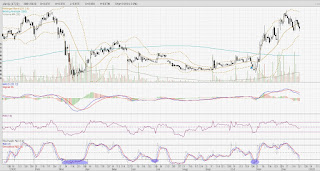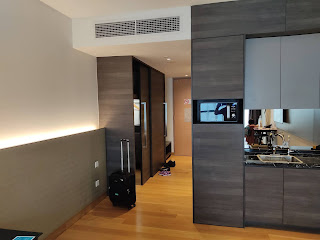We have seen that there are many people calling for "buys" on the plantation sector due to the rising CPO prices. If you wonder where to find out on the latest CPO prices, they are mainly transacted via futures. FCPO is Malaysia's main platform to trade CPO and take delivery in future months. Hence, FCPO remains a good gauge on what will be the price for the future prices of CPO.
Below is the snippets of FCPO prices as of 28/12/2020
 |
| FCPO prices taken on 28 December 2020 |
So, are Plantation stocks a buy now? Let's look at the facts below before we answer the question:
1. Plantation stocks are normally trading below NTA (P/NTA of 0.3 to 0.8 times - depending on plantation size, location of landbank, productivity/age-profile of trees, lands' proximity to development and production cost per tonne).
2. Plantation stocks are very cyclical and it normally has an uptrend during the CPO commodity price bull runs (due to a swell in earnings and potential dividend).
3. Some of the Plantation companies like Genting Plantation, IOICorp has emerged into a developer as well due to their land being very close to "development areas". Places like Kulai and Puchong are being developed by Genting Property and IOI Properties as they were ex-estates.
4. Production costs of FFB (Fresh Fruits Bunches) are estimated to be ~RM1,800. Due to logistical issue, cost structure of some more rural located plantation companies (especially at Sabah, Sarawak) has a slightly higher cost structure. Labour costs in peninsula Malaysia is slightly higher but at East Malaysia logistical issues often balloon the costs and also caused some FFB to degrade (hence commanding lower prices or even being dumped).
5. Some of the bigger companies like FGV, TSH has landbanks and operations outside Malaysia (mostly all in Indonesia). Sime Darby Plantation has acquired NBPOL in 2015 hence they now operate and own palm oil plantation in Papua New Guinea.
6. The fruits from the trees can be harvested, sent to the oil palm mill to produce Palm Oil. That is the priced asset. A young tree (normally defined as <7 years old) will yield very little FFB. Trees with age profile of 7 to 12 years old are normally deemed as young matured trees and I have read and seen some producing up to 18 tonnes/ha. The prime is said to be from 10 years of age until 23 years old where they can produce 18 to 25 tonnes of FFB/ha. This is again depending on the tree species. However, the machineries, mills and land cannot be monetize instantly. Land will take a longer time to be monetized as they need to be rezoned for other developments, divided into smaller plots and sold. The process usually take years to complete.
7. 1 tonne of FFB now sells for RM3,800 vs average production costs of RM1,800. The profit is tremendous as compared 9 months ago the average price is <RM2,500/tonne.
8. Some of the Plantation companies are very illiquid and thinly traded.
9. Tree stress will normally cause lower production after several months (6-9 months) of good production. Of course, dry weather is another root cause (while wet weather caused floods and harvesting issues leading to eventual reduction in production). This is one good reason on why CPO production and prices is always cyclical.
10. Windfall tax will be activated by Malaysian government (>RM3,000/tonne) and this is also a natural curb in profit. It's reported that in Jan 2021 a 8% Windfall tax will be collected.
Let's see how the companies in Bursa are being valued right now?
 |
| A truncated list of Bursa listed Plantation companies (filtered based on Market Cap) |
Based on the filtered list above, you can see that the biggest players include Sime Darby Plantation, IOI Corporation, KLK, Genting Plantation is trading at P/B value of >1. One can always argued that the land have not been revalued over the years and if revalued now the book value can be higher, hence reducing the P/B value.
In terms of P/E ratios, it might not be meaningful as months ago CPO prices were low and naturally profit is bad.
If you observe well, most of the companies have gone up from their 52 weeks low and now trading almost at their 52 weeks high.
Concerns
1. The share prices of most Plantation companies have risen and almost at their 52 weeks high. There is always a concern that despite the very likelihood in the hike in profits for the listed Plantation companies, it has already factored in all the good news. When the results come out, not all companies will report terrific profits (due to labour shortage factors, some companies' trees are either too young or old, logistical issues due to bad weather in Q4). Those who reports good profits might not experienced a sharp share price increased.
2. Some plantation companies like JTiasa etc has pretty weak balance sheet. Some of the East Malaysian companies also involved in timber business and that segment of business wasn't doing well.
3. Normalization of CPO prices. We can say that prices are market driven, so when prices rises it is due to sustained demand of CPO, the hike in price will dampen demand as well. Lower demand and potentially increase in production in coming months (especially after lots of rain from Sept onwards) could drive prices down.
4. Strengthening of Ringgit against US Dollar might put some pressure on CPO prices. The next edible oil which competes neck-to-neck with Palm Oil is Soybean and it's grown mainly in the West. Buyers buy CPO in USD and hence when RM appreciate, we will have to lower the price to compete with Indonesia.
Outlook? Is it still a buy now?
It is a difficult question to answer but our views are as below.
1. It is still possible to earn 10 - 30% profit by buying into Plantation companies. However, hoping for the stocks to double or triple up might be irrational (might happen in irrational market anyway).
2. CPO Prices are set to come down after March 2021. The highest should be Jan 2021 which is around RM3,750/tonne.
3. Stocks are trading with a 6 months lookahead. Hence, it might be forecasting a reduction in profit going forward already. A good quarterly result might not help much in stock prices. It's the "Greater Fool's theory" in play right now as we also need to ask ourselves who is willing to buy at a higher prices.
4. If you use the "margin of error" methodology, you might not be comfortable. Margin of error might be lower now due to the price hike.
5. If you want to take a bet, cherry-picking is the right way forward. Do make sure you read up the production of the Plantation companies (from Bursa's website as all plantation companies are required to post their monthly production figures).
























































